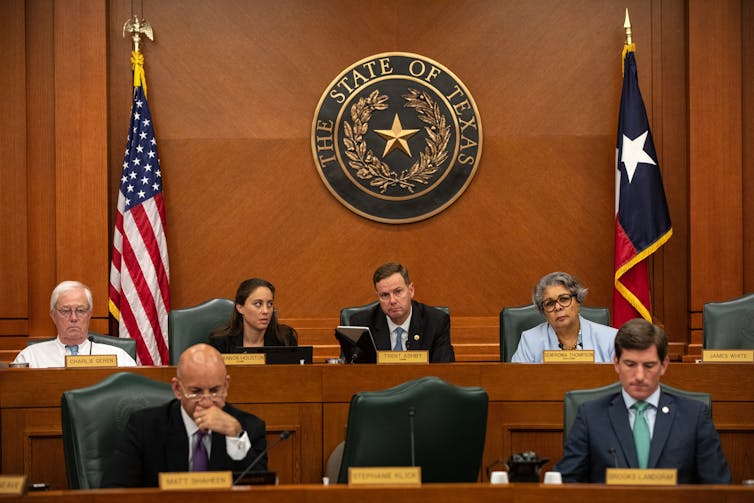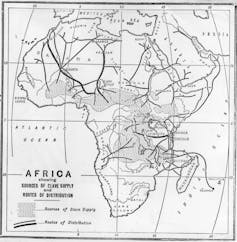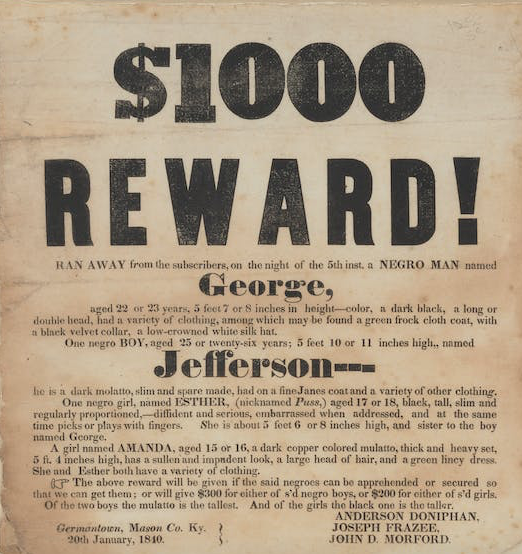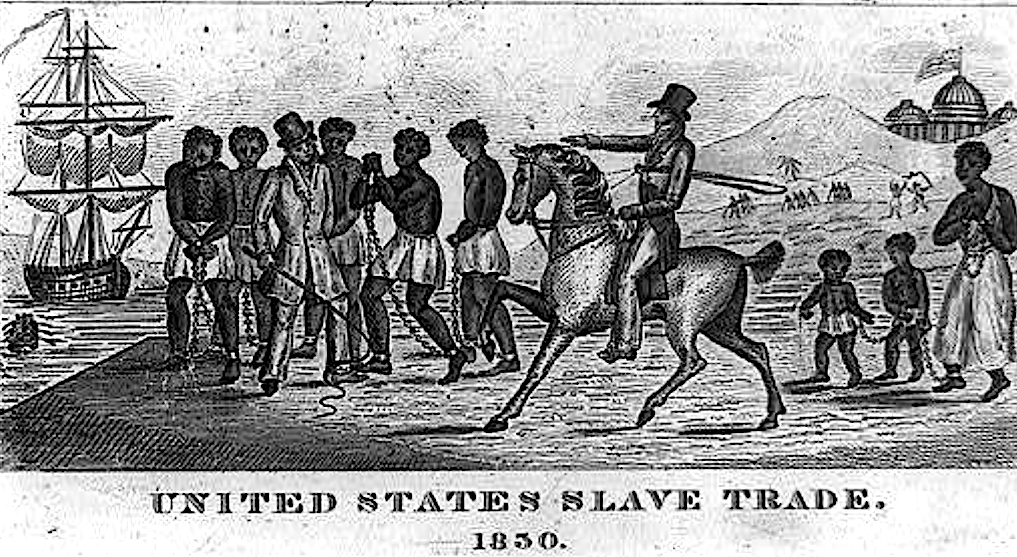As some politicians try to shackle educators with restrictive laws, Raphael E. Rogers recommends using historical records to show the role that slavery played in the forming of a nation.

A Texas law says slavery cannot be taught as part of the “true founding” of the United States. (Tamir Kalifa/Getty Images)
By Raphael E. Rogers
Clark University
 Of all the subjects taught in the nation’s public schools, few have generated as much controversy of late as the subjects of racism and slavery in the United States.
Of all the subjects taught in the nation’s public schools, few have generated as much controversy of late as the subjects of racism and slavery in the United States.
The attention has come largely through a flood of legislative bills put forth primarily by Republicans over the past year and a half. Commonly referred to as anti-critical race theory legislation, these bills are meant to restrict how teachers discuss race and racism in their classrooms.
One of the more peculiar byproducts of this legislation came out of Texas, where, in June, an advisory panel made up of nine educators recommended that slavery be referred to as “involuntary relocation.”
The measure ultimately failed.
As an educator who trains teachers on how to educate young students about the history of slavery in the United States, I see the Texas proposal as part of a disturbing trend of politicians seeking to hide the horrific and brutal nature of slavery – and to keep it divorced from the nation’s birth and development.
The Texas proposal, for instance, grew out of work done under a Texas law that says slavery and racism can’t be taught as part of the “true founding” of the United States. Rather, the law states, they must be taught as a “failure to live up to the authentic founding principles of the United States, which include liberty and equality.”
To better understand the nature of slavery and the role it played in America’s development, it helps to have some basic facts about how long slavery lasted in the territory now known as the United States and how many enslaved people it involved. I also believe in using authentic records to show students the reality of slavery.
Before the Mayflower
Slavery in what is now known as the United States is often traced back to the year 1619. That is when – as documented by Colonist John Rolfe – a ship named the White Lion delivered 20 or so enslaved Africans to Virginia.
As for the notion that slavery was not part of the founding of the United States, that is easily refuted by the U.S. Constitution itself. Specifically, Article 1, Section 9, Clause 1 prevented Congress from prohibiting the “importation” of slaves until 1808 – nearly 20 years after the Constitution was ratified – although it didn’t use the word “slaves.” Instead, the Constitution used the phrase “such Persons as any of the States now existing shall think proper to admit.”
Congress ultimately passed the “Act Prohibiting the Importation of Slaves,” which took effect in 1808. Although the act imposed heavy penalties on international traders, it did not end slavery itself nor the domestic sale of slaves. Not only did it drive trade underground, but many ships caught illegally trading were also brought into the United States and their “passengers” sold into slavery.
The last known slave ship – the Clotilda – arrived in Mobile, Alabama, in 1860, more than half a century after Congress outlawed the importation of enslaved individuals.

An 1880 map shows where enslaved people originated and in which directions they were forced out. (Hulton Archive/Stringer via Getty Images)
According to the Trans-Atlantic Slave Trade database, which derives it numbers from shipping records from 1525 to 1866, approximately 12.5 million enslaved Africans were transported to the Americas. About 10.7 million survived the Middle Passage and arrived in North America, the Caribbean and South America. Of these, only a small portion – 388,000 – arrived in North America.
Most enslaved people in the United States, then, entered slavery not through importation or “involuntary relocation,” but by birth.
From the arrival of those first 20 so enslaved Africans in 1619 until slavery was abolished in 1865, approximately 10 million slaves lived in the United States and contributed 410 billion hours of labor. This is why slavery is a “crucial building block” to understanding the U.S. economy from the nation’s founding up until the Civil War.
The Value of Historical Records
As an educator who trains teachers on how to deal with the subject of slavery, I don’t see any value in politicians’ restricting what teachers can and can’t say about the role that slaveholders – at least 1,800 of whom were congressmen, not to mention the 12 who were U.S. presidents – played in the upholding of slavery in American society.
What I see value in is the use of historical records to educate schoolchildren about the harsh realities of slavery. There are three types of records that I recommend in particular.
1. Census Records
Since enslaved people were counted in each census that took place from 1790 to 1860, census records enable students to learn a lot about who specifically owned slaves. Census records also enable students to see differences in slave ownership within states and throughout the nation.
The censuses also show the growth of the slave population over time – from
697,624 during the first census in 1790, shortly after the nation’s founding, to 3.95 million during the 1860 census, as the nation stood at the verge of civil war.
2. Ads for Runaway Slaves
 Advertisements for fugitive slaves offer a glimpse into their lives.
Advertisements for fugitive slaves offer a glimpse into their lives.
Few things speak to the horrors and harms of slavery like ads that slave owners took out for runaway slaves.
It’s not hard to find ads that describe fugitive slaves whose bodies were covered with various scars from beatings and marks from branding irons.
For instance, consider an ad taken out on July 3, 1823, in the Star, and North-Carolina State Gazette by Alford Green, who offers $25 for a fugitive slave named Ned, whom he described as follows:
“… about 21 years old, his weight about 150, well made, spry and active tolorably fierce look, a little inclined to be yellow, his upper fore teeth a little defective, and, I expect, has some signs of the whip on his hips and thighs, as he was whipped in that way the day before he went off.”
Advertisements for runaway slaves can be accessed via digital databases, such as Freedom on the Move, which contains more than 32,000 ads. Another database – the North Carolina Runaway Slave Notices project – contains 5,000 ads published in North Carolina newspapers from 1751 to 1865. The sheer number of these advertisements sheds light on how many enslaved Black people attempted to escape bondage.
3. Personal Narratives from the Enslaved
Though they are few in number, recordings of interviews with formerly enslaved people exist.
Some of the interviews are problematic for various reasons. For instance, some of the interviews were heavily edited by interviewers or did not include complete, word-for-word transcripts of the interviews.
Yet the interviews still provide a glimpse at the harshness of life in bondage. They also expose the fallacy of the argument that slaves – as one slave owner claimed in his memoir – “loved ‘old Marster’ better than anybody in the world, and would not have freedom if he offered it to them.”
For instance, when Fountain Hughes – a descendant of a slave owned by Thomas Jefferson who spent his boyhood in slavery in Charlottesville, Virginia – was asked if he would rather be free or enslaved, he told his interviewer:
“You know what I’d rather do? If I thought, had any idea, that I’d ever be a slave again, I’d take a gun and just end it all right away, because you’re nothing but a dog. You’re not a thing but a dog. A night never come that you had nothing to do. Time to cut tobacco? If they want you to cut all night long out in the field, you cut. And if they want you to hang all night long, you hang tobacco. It didn’t matter about you’re tired, being tired. You’re afraid to say you’re tired.”
It’s ironic, then, that when it comes to teaching America’s schoolchildren about the horrors of American slavery and how entrenched it was in America’s political establishment, some politicians would prefer to shackle educators with restrictive laws. What they could do is grant educators the ability to teach freely about the role the slavery played in the forming of a nation that was founded – as the Texas law states – on principles of liberty and equality.![]()
Raphael E. Rogers is professor of practice in education at Clark University.
This article is republished from The Conversation under a Creative Commons license. Read the original article.
The views expressed are solely those of the author and may or may not reflect those of Consortium News.


The bottom line about slavery is that it is every capitalist’s wet dream: the legalized systemic theft of your employees’ wages. Having a pool of helpless victims to act out your personality disorders on was just icing on the evil cake. Slavery advocates bragged they had solved capitalism’s most vexing problem, the relation of capital to labor, by converting their labor force into a capital asset. Extremists advocated extending the system to whites who labored in what Blake had justly called the “dark, satanic mills” of the industrial north. Yet, so much pro-slavery literature reads like the self-deceiving rationalizations of very guilty consciences. It is often forgotten that the earliest antislavery societies formed in the slave states, where the stark terror of “servile insurrection” haunted the “lords of the lash” who well knew how morally indefensible their institution really was. But as one author put it, give a slaveholder a heavy bag of gold coins and a feather-light declaration of liberty, and see which one he lets go of first.
Slavery exists today in the US under the guise of criminal justice system.
and undocumented workers….
Thank you Raphael, teaching the history is so important. I must admit that I am kind of delighted that the Texans have at least acknowledged that slavery was a “failure to live up to the authentic founding principles of the United States, which include liberty and equality.” I’m sure the slaves and servants, former prisoners, appreciated such rhetoric. Indeed the rhetoric tried to hide slavery from such high-minded ideals. It is those high-minded ideals that I want everyone to focus on rather than burying the history. As Carl Sagan said, “We must know the past to understand the present.”
Suppressing the history in this country has always been about protecting power. Slavery, however, was hard to keep a secret unlike some other subjects also erased from our history also having to do with protecting the existing power structure. Ever wonder why there was never a class on money, what it is, where it comes from, how it is created? Not even at the university level, economics students are taught the same myth that most people believe about money. That is because money is power and that power is used to dominate all industry and government.
Money and wealth is what slavery was all about. Even as many as 70% of the white population in the colonies were indentured servants. Slavery was part of the world’s reality then, the US didn’t invent it but exploited it to the hilt. One might ask then, servants and slaves for whom? Of course it was a privileged few who enjoyed the wealth created by the many, and today we all serve a privileged few and because people don’t know the history, not even their own country’s rich monetary history that shows how democracy is averted. Most don’t know how the elite do it or even that they are doing it, suffering under the illusion that we are a democracy. History reveals the unresolved issue of power which we can gather from historical quotes.
“The problem of the modern economy is not a failure of a knowledge of economics; it’s a failure of a knowledge of history.” — James Galbraith
Universal historians will be valuable only when they can reply to history’s essential question: What is power? History can only be explained by introducing a power which they apparently do not recognize.” – Leo Tolstoy
“The issue which has swept down the centuries and which will have to be fought sooner or later is the people versus the banks. “ — Lord Acton
”To better understand the nature of slavery and the role it played in America’s development, it helps to have some basic facts about how long slavery lasted in the territory now known as the United States and how many enslaved people it involved. ”
‘Slavery was never abolished, it was only extended to include all the colors’ (Charles Bukowski).
1848: The proletarians have nothing to lose but their chains. They have a world to win. WORKING MEN OF ALL COUNTRIES, UNITE!’ (The Communist Manifesto, Marx & Engels).
1892: ‘The old master class was not deprived of the power of life and death, which was the soul of the relation of master and slave. They could not, of course, sell their former slaves, but they retained the power to starve them to death, and wherever this power is held there is the power of slavery. He who can say to his fellow- man, You shall serve me or starve, is a master and his subject is a slave….Though no longer a slave, he is in a thralldom grievous and intolerable, compelled to work for whatever his employer is pleased to pay him.’ (Life and Times of Frederick Douglass).
1928: ‘Earning a wage is a prison occupation’ (Wages, DH Lawrence).
2020: ‘Target Workers Unite recently released a survey of more than 500 Target workers around the US, representing 382 different stores in 44 states. Only 12.7% of the workers who responded said they could survive on the wages from Target alone, with 56% of workers citing they have run out of food while employed at Target, and 12.8% of workers reported experiencing homelessness’ (‘Target raised wages. Then it cut workers’ hours and doubled their workload’, The Guardian. 27 February). Target’s annual gross profit for 2019 was $22.057bn.
Certainly Dr. Johnson and others thought is massively hypocritical for slave-owners to rant about “liberty,” during the War pf Independence. Likewise, quite a few slaves enlisted in the King’s army, for freed0m and pay!
Bolivar’s wars of independence in South America definitely were anti-slavery, pro-abolition, almost from the beginning.
As a historian of the US, I support Raphael Rogers’ facts and analysis and suggestions. It is critical that children and adolescents learn the history of slavery and, of course, other forms of racial, class, and gender domination and resistance. East Asians were gravely oppressed, but not enslaved in the hundreds of thousands to millions. 300K population in 1880, down to 100K in 1890; after Chinese Exclusion Act was passed and also because of violence, Chinese left. Only Georgia was founded with indebted prisoners.
By the time students get to college, they often react by claiming slavery was “long ago” and thus irrelevant. 1619-1865=246years of slavery. 1865-1965=100years of Jim Crow; together, 350years. 1965-2022=57 years, roughly a sixth of the time compared to institutionalized racism.
So much info is available online that people can check their assumptions before making inaccurate statements. (PS; I’m a white girl, FWIW.)
What a splendid group of “educators”. After “collateral damage” and “economic migrants” we now have “involuntary relocation”!
Perhaps, if we ask them nicely, they can come up with an appropriate term for ethnic cleansing?
The newest fad? If parts of any history is not liked, just change it or better yet, voided all together. Average Americans are poorly educated and certainly do NOT need this on top of everything else.
I wonder if we can “involuntarily Relocate” these people (racists) to where their ancestors came from.
I am given to understand Puerto Ricans have a saying. “You can cover the sky with your hands”. Translation: place both hands over your eyes and the sky disappears; therefore, the sky does not exist.
There is no free speech…there is no freedom in America.
We do not live in a democracy, that’s for sure. The U.S. is an oligarchy run amok.
I have never yet met an American who knows the historical fact that the USA was founded as a colonial dumping ground for British overstuffed prisons, in exactly the same way white Australia was founded. That too, is clearly not taught to the American people of today, and I wonder if it ever was taught. Frequently, when an American can’t win an argument, they will frequently throw the prison colony of Australia as an insult, little knowing that is how the USA too was founded. American exceptionalism depends on the lie they never were a penal colony and never imported black slaves from Africa. Given that even Obama sprouted American exceptionalism, it is absolutely laughable that they hang onto this distorted image of themselves.
I think I recall being taught that Georgia, the 13th colony, was originally a penal colony. That course would have been taught in Georgia in the 1950’s. If my memory is playing tricks on me, it’s because that was so long ago.
Well, you’ve met one now. Don’t lump all Americans into the category of ignorance. I was taught this history in the 1960s when I was in junior high school. It’s true that the standard of public education has plummeted in the intervening years, but that is capitalism at work. I am of a generation that was still being taught history.
Yes, educators should be allowed to teach freely “the role the slavery played in the forming of a nation that was founded …on principles of liberty and equality.” That does not imply impeaching the founders for hypocrisy, because at that time those of the South had little choice: they could not unilaterally pay wages and survive in the market.
The slaves were not yet readily integrated, and there was no practical precedent for large social programs or large federal agencies. A wholesale tax on the slave product (cotton) could have subsidized wages and the building of towns etc. for former slaves, with no economic effect upon slaveholders. The abolitionists were in the northern states and England, the main purchasers of cotton, so they were bound to pay the costs of abolition anyway. That road would have been bumpy due to residual racism among poor southern whites, but much shorter, and the solution would have prevented the Civil War with roughly 600,000 deaths, more than any other US war.
But the solution was never debated or even proposed: it was too new, too large even for consideration. The fault in the founding documents was seen in 1820-1860 when the founders died off and Congress became a circus of regional demagogues, unable to debate solutions. The few debates in Congress failed to even gain acceptance of the legitimate concerns and constraints of both sides. The 1858 Lincoln-Douglas Debate did not raise any practical plans. The southern states not yet seceded sought to set up real debates but few would participate, and were pre-empted by war.
The US still lacks any real means of policy debate under non-partisan control. New institutions should form a new public mind, with new ways of thinking to permit public debate, the celebration of public spirit and human values lost in our culture of greed, lying, and bullying.
I am working to set up the Congress of Policy Debate (CongressOfDebate dotcom) constituted to protect all points of view, and to conduct moderated text-only debate among university experts of several disciplines, of the status and possibilities of each world region, and the policy options. Debate summaries commented by all sides will be made available for public study, mini-quizzes, and comment.
Can’t help but see Republican efforts to rewrite the history of the country as anything other than Orwellian. An educated citizenry capable of critical-thought has always been diametrically opposed to the interests of the ruling class.
It isn’t just Republicans. Please stop letting the Democratic Party off the hook. Both parties are capitalist and both have contributed to the lowering of educational standards in this country. I support neither of them.
I like it, I would love it if it hadn’t forgotten to mention native americans and others such as Asians being enslaved , hundred of thousands to millions (at least I think it was omitted in this article). Slavery is less about a race or numbers (we should go beyond that by now), it is about people being stripped/deprived of the right to live, to act, and to be… that is what I believe
What is your source for the hundreds of thousands to millions of Asian slaves in the US?
Jamie didn’t say “in the US.”
I find the current discourse on American slavery incredible.
Let’s have the whole story. Slavery of black Africans started in Africa, by Africans.
Many Africans were sold to Arabs and beyond, to SE Asia.
Slavery and the trade in slaves has existed for millennia.
There were slaves in antiquity.
Slaves in Rome.
The common lot of those whose leaders lost wars was to be enslaved.
Also maybe to be castrated, mutilated, such as having one foot cut off so the slave could not escape or one ankle tendon cut for the same purpose. Or both.
White slave traders were literally late to the trade.
It was in England that this trade was first legally abolished.
Every educated American understands the general outlines of the role of slavery in the history of the USA.
I am, actually, getting sick and tired of the one-sided guilt trip being laid on Americans, lifted completely out of the context of the history of world slavery and the slave trade: within Africa, between African and the Middle East and India, within China, within the kingdoms of the East Indies, and in other settings around the globe.
For background on the slave trade within Africa and its relation to the trade to the Americas I recommend John K. Thornton, A Cultural History of the Atlantic World. Both Thornton and his wife specialize in the history of Africa.
I agree with you. Of course colonizers do not recognize the humanity of those whom it would enslave and exploit. It is still going on. What do you think the working class is to the oligarchs but virtual slave labor that doesn’t deserve a living wage, free health care, pensions, etc.?